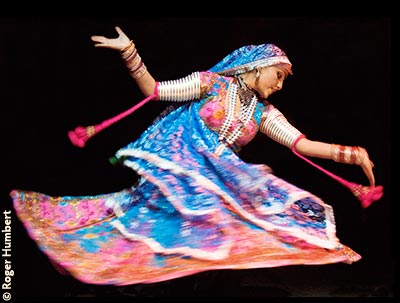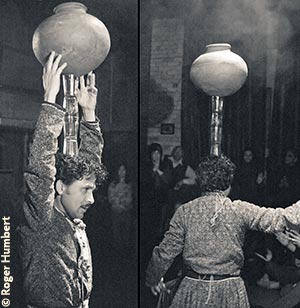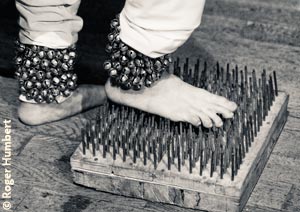
|
Dhoad Gypsies of Rajasthan
presented by Small World Music |
|
| February 26, 2009 • Revival • Toronto |
|
|
|
|
|
|
The Gypsies that Europe Never Met
by Tova G. Kardonne with photos by Roger Humbert |
| A beautiful man strutted triumphantly on stage and raised his arms to the crowd, as if to say, how delightful! The room is full of wonderful people! The audience, despite its exuberantly positive vibe, was confused as to how to respond. There was a smattering of applause, as if to say, hurrah! What’s going on? |
| That happened a few times during the performance of the Dhoad Gypsies of Rajasthan at Revival on February 26. We, in Toronto, are just not used to the slow revealing of a full family of performers. We don’t expect contortionism with our live music. We aren’t sure how to react to the guy walking on a bed of nails. We’re out of our element when adolescent boys, appearing to get along well with their family, sing with full showman’s bravado, work the crowd in exhibiting proficiency on various instruments, drop a single hip repeatedly a-la-belly dancer, dressed entirely in loud pink. These are all anomalous behaviours around here.
But the Dhoad Gypsies aren’t from around here. Rajasthan, in north-western India, marked the starting point from which the Gypsies wandered all over South Asia, North Africa and Europe. Anyone expecting the Eastern European/Western European fusion that represents what we normally think of as Gypsy music will be taken aback by these sounds, having remained in a sphere of influences that includes some very old Rajasthani traditions indeed, but also Bollywood and Indian classical music and dance.
|
|
|
|
| The performance was structured like street theatre: It started small and purely percussive, and introduced new elements every 20 minutes or so, from the 15-year-old’s voice and harmonium, to the hand-held clickety-click percussion instruments (ancestor of the castanet?), to dancing and contortionism, to a man balancing of a huge water-filled clay jar on his head while walking on water glasses and nails and the amazing virtuoso singing of the venerable elder members of the family. The impressive micro-tonal vocal inflections and intricate rhythmic backdrops would normally be the main feature of any article on this music, were I reviewing a CD or a performance in a posh concert hall. These artists certainly could hold their own in the most prestigious venues and before the most discriminating ears. But having seen them in a club, and been witness to their exuberant, interactive, joy-filled live show, it seems clear that the high-caliber music is clearly only a part of the Dhoad Gypsy performance tradition. This is the old-school package: entertainment for the whole family, from the little ones who would hide their faces when the bed of nails is brought out, to the chin-stroking grandparents with a broad basis for comparison with other such families of artists. Not to mention the middle generations, who have ample opportunity to wiggle and flirt to the dramatically sexy beats.
Like the gypsies of my folk-tale-sourced dreams, the Dhoad Gypsies passed through Toronto, as they have through many a far-flung city, enchanting and delighting as they went.
|
|
|
|
|
|
|
|
|





